
Issue No. 2 - August/September 1998
|
|
 |
Back Issues:
Issue
1
If
you came direct to the Cheesewire and want to visit our main site,
click here |
|
Gift Vouchers
Maybe the answer to
those awkward gift choosing moments could be solved for ever, the sock
drawer given a rest and the cheese larder restored.
Gift vouchers are now
available at £10 and £20 which can be used both in the shop or for mail
order.
|
|
Welcome to the second issue of the Teddington Cheese Wire. We would like
to thank everyone who wrote to us or called into the shop to tell us how
much they enjoyed the first edition. We hope that you will enjoy our second
edition just as much. |
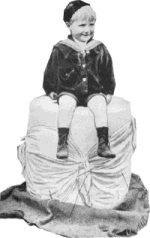
The Biggest Cheshire Cheese
Taken at the Cheshire Cheese Fair, June 1909. |
Following our first issue we have welcomed a number of
new members to our cheese club which continues to go from strength to strength.
Our caption competition proved to be popular and we hope that those who
have not won this time will try again.
In our next and subsequent issues we will add a readers
section where we answer any questions that you may have about the world
of cheese. We will also bring you the results of the 5th British Cheese
Awards to be held this September at Cadogan Hall in Chelsea.
|
|
This event gives us an ideal opportunity to make contact
with new British and Irish cheesemakers and to meet with our regular suppliers.
We are planning more expeditions to small farms in various
parts of Europe and we hope to return with some real cheese treasures.
For those on line and using the internet we have now
updated our site (www.teddingtoncheese.co.uk) which now includes a shopping
basket system to make ordering easier. Why not take another look!
|
|
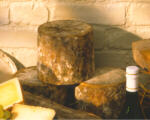
Baby Cheddars for Christmas
Montgomery baby cheddar truckles are made for us at Manor Farm in
the Spring and are matured ready for the Christmas dinner table. Only
a small number are made each year and this Christmas we are reserving
these cheeses for individual customers on a first come first served
basis. Each cloth bound truckle weighs between 5 and 6lbs.
Alternatively, why not try a piece cut from our 25kg (56lb) large
truckles. Available all year round.
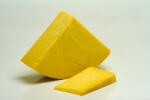
|
|
|
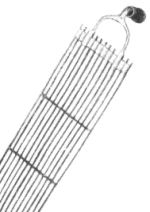
Vertical cheese knife:
This is passed through the curd twice, the
second pass at 90º from the first.
|
|
Tools of the trade
Curd Knives
|
Curd knives have been used for
hundreds of years and they come in many shapes and sizes but their
function is basically the same. To understand how and why they are
used some knowledge is needed about how cheese is made: Milk is poured
into vats and allowed to sour. Souring is accelerated by the addition
of a 'starter' - this can be a little sour milk from the previous
day or a manufactured dried powder.
|
When the milk has soured a 'rennet'
is added - this is an enzyme which causes the structure of the milk
to change and causes it to set in a similar way to a blancmange.
It is at this point that the curd knives are brought into use. They
are passed through the mass cutting it one way, and then the other
until there are thousands of small cubes of approximately 1cm in
size. The small cubes release a liquid (whey) and the cubes (curds)
gradually dry and shrink. The whey is drained off and the curds
are used to make the cheese.
|
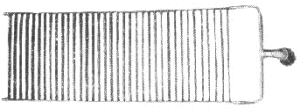
Horizontal cheese
knife: This
is passed through the curd once
|
|
|
|
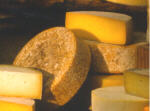 |
Cheese focus:
Double Gloucester
Diane Smart, Birdwood, Gloucestershire, England
|
|
Along the Vale of Gloucester and
the Vale of Berkeley is the land of Gloucester cheese. It is believed
to have been made there for over a thousand years and has been known
both as Gloucester and Berkeley cheese.
Gloucester cheese is available
as both double and single. The double is larger and fuller flavoured
than the single, which possibly explains its name. It keeps for longer
and therefore travels better. This is why it is more well-known then
the single variety. Single Gloucester is made
with skimmed milk from the evening
milking mixed with full cream milk from the morning milking. Double
Gloucester uses full cream milk from both the evening and morning
milkings, another possible reason for it being called Double. Both
Gloucesters are sturdy cheeses. In times gone by cheese buyers would
actually jump on any doubtful specimens to test their strength.
Although old cheeses, the Gloucesters
only became popular at the beginning of the eighteenth century. This
increase in popularity was linked to a new rind treatment which enabled
the cheese to travel to the major towns and cities without spoiling.
The treatment involved leaving the cheeses on the curing room floor
which was regularly rubbed with bean and potato stalks, leaving a
wet black deposit. The cheeses were turned twice a week. They developed
rinds as tough as leather and thus improved their keeping qualities.
Later came the practice of using carrot and beetroot juice to colour
the cheese. This was done since the myth was rife that the rosier
the colour the richer the cheese. Nowadays annatto is used for colouring.
Gloucester cheese has a rich history.
The cheeses are used in various festivals which mark the beginning
of Spring. One of these occurs on Rogation Sunday in the small village
of Randwick, which in old Anglo-Saxon means 'the dairy farm on the
hill'. Three cheeses are decorated with flowers and carried through
the streets. They are then carried into the church accompanied by
singing and dancing. After the removal of the decorations, the cheeses
are rolled three times anti-clockwise around the church. They are
then dressed up again and taken back to Randwick where one is cut
up and distributed to the parishioners. The other two are kept for
Wap Fair, the following Saturday, when they are rolled down the hill.
Another ancient custom was the event held on Coopers Hill near Gloucester
City, laterly on Whit Monday, formerly on Midsummer's day. Four cheeses
were decorated with ribbons and set off down the hill with individuals
taking chase in an attempt to catch them before they reached the
bottom. Unfortunately, bruises and broken bones were frequently the
result. The event was halted only this year (1998) by the police
in the interest of public safety.
Smarts Double Gloucester is made
from unpasteurised cows' milk with a vegetarian rennet. It has a
bright orange waxy paste, a strong mellow flavour and a tough natural
rind. Cheeses are aged for at least four months but can be matured
for eight months and more. Each cheese is approximately 3kg in weight,
50 to 75mm in height, 250mm in diameter and has a 48% fat content.
The cheese is ideal in salads, can be used in cooking or as part
of a cheese board. It tastes excellent with a glass of red wine and
dry biscuits.
|
|
|
|
Double
Gloucester Soufflé Omelette
serves 2
ingredients:
5 large eggs
100g Smart's Double Gloucester (grated)
2tbsp chopped chives
freshly ground black pepper pinch of salt
butter for frying
1. Separate the eggs.
2. Beat the whites until they form soft peaks.
3. Beat the yolks and season with salt and pepper.
4. Fold the yolks into the egg whites together with half of the Double
Gloucester and the chives.
5. Warm the butter in a frying pan and then add the mixture and fry
for 2 minutes.
6. Sprinkle the remaining cheese over the top and place under the grill
for 2 minutes.
7. Serve on a salad of mixed leaves.
|
|
- Cheese Tips -
Using hard cheese rinds for flavouring soup
Cheeses which are matured for one,
two or even three years develop a rind which is thick, hard and dry.
This rind is usually discarded and the inner softer cheese is eaten.
The rind is basically concentrated cheese and forms a strong protective
layer for the remaining cheese. Older cheeses, for example Parmesan,
tend to be the most expensive and consequently, discarding the rinds
can be particularly painful.
A solution to this problem is to be
found in Italy where the rinds of Parmesan, when cleaned, are dropped
into soup during its making and impart a wonderful flavour and aroma.
After a little time the softened rinds are 'fished out' and eaten.
Back to top
|
|
|
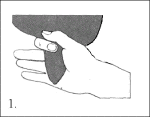
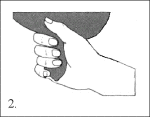
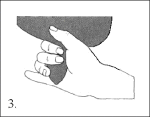
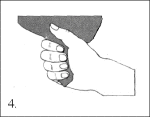
|
Milking your goat
In our first issue of the Teddington Cheese Wire
we outlined the points to look out for when choosing your milking
goat. No doubt the many readers who have found and bought their goat
will now need to learn how to milk it.
Cleanliness is of the utmost most importance during
and after milking. You should arrange the milking away from the goat
shed in a separate room or stall, with a further room next to the
milking area which will be a dairy. There should be a door separating
the two. When milking the goat, it can stand on a platform with the
milker standing behind, or a small milking stool can be employed
with the goat standing on the ground.
Whilst learning to milk it may be a good idea
to distract your goat from your 'ham-fisted' efforts by giving it
some goat concentrates to eat. Avoid foods such as turnips, swedes,
kale and silage during, and for four hours before milking, since
this will taint the milk. It is also advisable to restrain the goat
with a collar until you can milk expertly.
Just before milking, when your goat is tied up
and eating, her udder and hind quarters need to be wiped down with
a damp cloth soaked in a solution of a suitable udder wash. A small
amount of udder cream should be put on the teats and hands. If you
have not yet taken possession of your goat, it may be a good idea
to practice the milking technique described below, with the finger
of an old rubber glove with a pin-hole in the tip.
Gently grasp the teat with the hand but never let
the tips of the fingers touch the teat. Pressure is applied by the
first finger in order to hold the milk in the teat, and then by the
second, third and fourth fingers in turn in order to force the milk
out. The grip is then relaxed to allow more milk into the teat, then
the procedure is repeated. The arms should be kept quite still with
the hands doing all the work. The first four jets of milk from each
side should be milked into a strip cup. This is a special container,
holding about one pint, with a handle and a shelf of black plastic
halfway down the inside; with it you can detect flaky or stringy
milk which will indicate mastitis and other problems.
When the milk stops flowing, gently massage the
udder until there is more milk in the teats and then milk out as
before. Continue until the udder is empty. Milking is easy once mastered
but it important to avoid the bell ringers style, which although
is the quickest , is not good for the goat. When milking is completed
the churn should be taken to your dairy for making cheese or straining,
bottling and cooling until needed in the kitchen.
|
|
|
|
BACK TO TOP
|
|
|
| All
articles © www.teddingtoncheese.co.uk |
|
|











